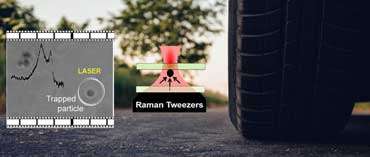Swedish scientists at the University of Gothenburg have developed a technology to detect small tyre wear particles that previously were too tiny to be noticed. A new study shows that a form of optical tweezers can be used to detect small microplastics from tyres and road wear. The results can be used to develop more sustainable tyres that produce less pollution.
Tyre and road wear particles are very small microplastics generated by road transport means during the mechanical abrasion of tyres, brakes, and roads. The particles are accumulated on the roadsides and then run off into watercourses where they pollute the water ecosystem. Whilst the amount of pollution from larger microplastics is known, there has been a technological gap in the detection and analysis of the fraction of these smaller particles.
In a new study (Environmental Science: Nano, “Raman tweezers for tire and road wear micro- and nanoparticles analysis”), by using a combination of optical tweezers and Raman spectroscopy called Raman tweezers, researchers have for the first time been able to detect and examine particles from tyres and roads less than five micrometre in size. With the Raman tweezers, the researchers can trap and chemically analyse individual particles in a liquid environment.
“The research shows that we can use this combination of optical tweezers and Raman spectroscopy to characterise the microscopic particles that are created by the abrasion of tyres on roads and often end up in the sea. This closes a gap between other available techniques, in terms of size,” says Giovanni Volpe, professor at the Department of Physics.
The research project is an international collaboration led by Pietro Gucciardi from the CNR Institute for chemical and physical processes in Messina, Italy.
The potential of Raman tweezers in environmental pollution analysis contribute to fill the technological gap for detection and identification of nanoplastics. The technology can be used to create more sustainable tires that does not create these polluting particles.
“The results from the study could be used to develop tires that produce less pollution or more biodegradable microparticles,” says Giovanni Volpe.

